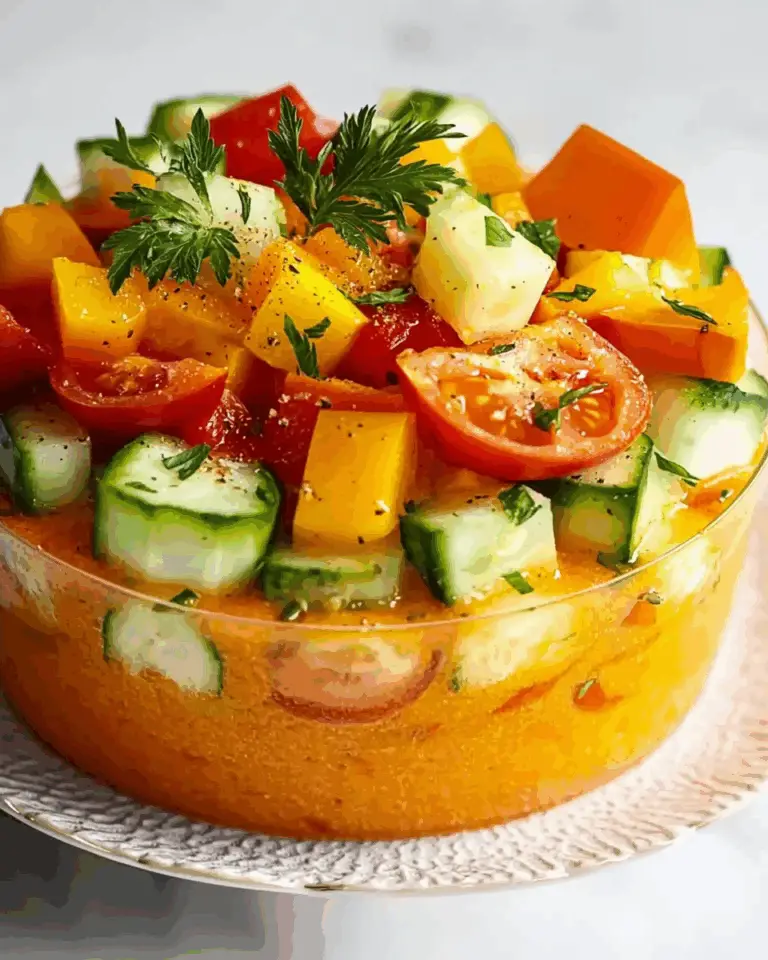A Culinary Classic With Centuries of History
Originally born from the kitchens of Andalusia, gazpacho was once a humble peasant dish, crafted from stale bread, olive oil, garlic, vinegar, and water. As trade and agriculture evolved, the soup transformed into the tomato-based version that’s so beloved today. With the introduction of New World ingredients like tomatoes and bell peppers, gazpacho evolved into the colorful and flavorful chilled soup we now associate with Spanish cuisine. Today, it remains a staple across Spain during the hot summer months—served in cafes, homes, and even upscale restaurants.
Why Gazpacho Is the Perfect Summer Dish
What makes gazpacho so perfect for summer isn’t just its chilled serving temperature—it’s the freshness of the ingredients. The soup is essentially a liquid salad, blended into a smooth, cooling emulsion that nourishes the body and satisfies the palate. There’s no cooking involved, which means you preserve the full spectrum of vitamins, minerals, and antioxidants found in raw vegetables. The cooling effect of cucumber, the sweetness of bell pepper, the acidity of tomato, and the slight bite of garlic and vinegar create a balance that’s refreshing and deeply energizing.
The Power of Quality Ingredients
Since gazpacho is a raw preparation, the quality of each ingredient is paramount. Heirloom or beefsteak tomatoes provide sweetness and juiciness that serve as the foundation of the dish. A ripe orange bell pepper brings mild sweetness and color contrast, while cucumber adds crispness and hydration. Shallots and garlic offer depth and heat, cut beautifully by the brightness of sherry vinegar and the richness of extra virgin olive oil. Even the bread, typically used in traditional recipes to add body, can be turned into crunchy croutons for a modern garnish. Each component plays a specific role in delivering flavor and texture.
A Healthy Soup With Serious Benefits
Gazpacho is as healthy as it is delicious. Packed with fiber, vitamins A, C, and K, and plenty of antioxidants like lycopene from the tomatoes, it’s a nutrient-dense choice that supports immunity, skin health, and digestion. It’s naturally low in calories, fats, and sugars, making it ideal for anyone following a plant-based, low-calorie, or heart-healthy diet. With just over 100 calories per serving and no added cream or cheese, it offers satisfying flavor without compromising nutrition.
Texture and Temperature: The Secrets to Perfection
The hallmark of a great gazpacho lies in its texture and chill. A well-blended gazpacho should be silky smooth but not watery—emulsified just enough for the olive oil and vegetable juices to harmonize. It should coat the spoon slightly but never feel thick or pasty. Chilling the soup for several hours—or even overnight—not only enhances the flavor but also thickens the consistency slightly, yielding a richer mouthfeel. This resting time allows all the ingredients to meld, making every spoonful more vibrant and complex.
Croutons and Garnishes for Contrast
While the soup itself is luxurious and smooth, what elevates the experience is the contrast of toppings. Crispy, golden croutons made from sourdough bread add a welcome crunch and a touch of earthiness. Diced cucumber and bell pepper sprinkled over the top introduce freshness and texture, while a drizzle of olive oil adds richness and sheen. For a final flourish, microgreens or a few torn basil leaves bring herbal notes and an elevated aesthetic—turning a rustic recipe into a gourmet presentation.
Versatility in Presentation and Use
Gazpacho isn’t confined to one type of meal or serving style. Serve it in a wide bowl for lunch, pour it into shot glasses for a cocktail party appetizer, or bring it on a picnic in a chilled thermos. It’s also a fantastic base for more elaborate dishes—pair it with grilled shrimp, hard-boiled eggs, or even a swirl of yogurt for added protein. You can use yellow tomatoes for a golden version, add watermelon for a sweet twist, or spice it up with jalapeño and cumin for a more southwestern flair.
A Make-Ahead Marvel for Entertaining
One of gazpacho’s best qualities is how well it holds up in the refrigerator. Made ahead of time, it only gets better as the flavors continue to develop. This makes it a host’s best friend—easy to prep in advance, store in jars or pitchers, and serve straight from the fridge with zero last-minute effort. When entertaining, that kind of convenience is priceless. Guests are always impressed by its vibrant color and clean, refreshing taste, especially on a hot day.
Tips for the Best Gazpacho Experience
For best results, peel the tomatoes to ensure an ultra-smooth texture—blanching them briefly in boiling water makes this easy. Use a high-powered blender or food processor to achieve the right consistency, and always taste before chilling, as flavors can mellow during refrigeration. Don’t over-garlic; raw garlic gets stronger as it sits. If your soup is too thick, add a splash of water or more olive oil; if it’s too thin, add extra cucumber or bell pepper to adjust.
Conclusion
Gazpacho is more than a chilled soup—it’s a celebration of seasonal produce, a testament to the power of simple ingredients, and a delicious nod to Spanish culinary tradition. It’s vibrant, refreshing, nutritious, and endlessly adaptable. Whether you’re looking for a light and hydrating dish to beat the summer heat, a stunning starter for your next dinner party, or a make-ahead lunch that feels gourmet with zero fuss, gazpacho fits the bill perfectly. This iconic dish reminds us that sometimes the best meals are the simplest ones—crafted not from complexity, but from freshness, balance, and a little Mediterranean sunshine in every spoonful.






